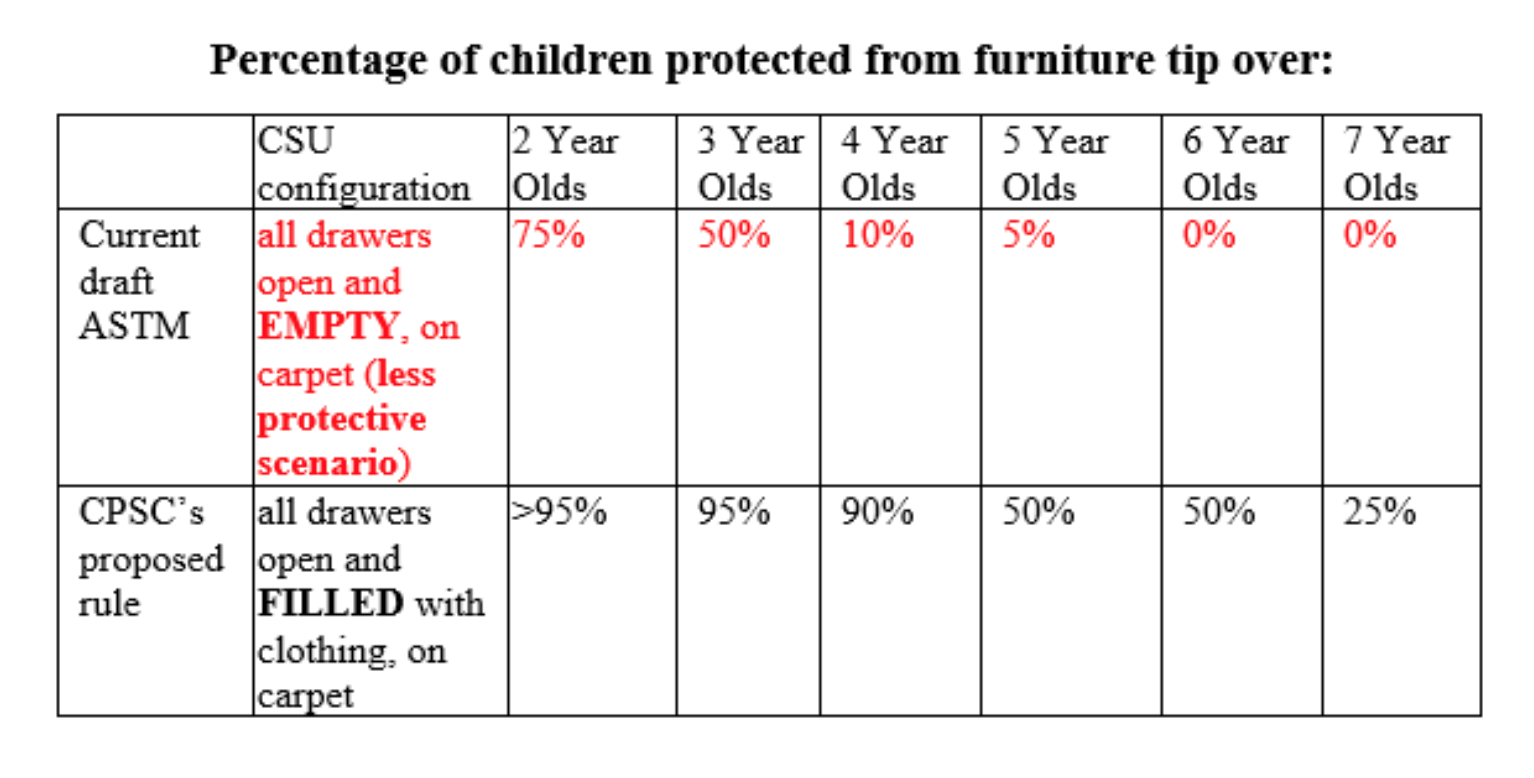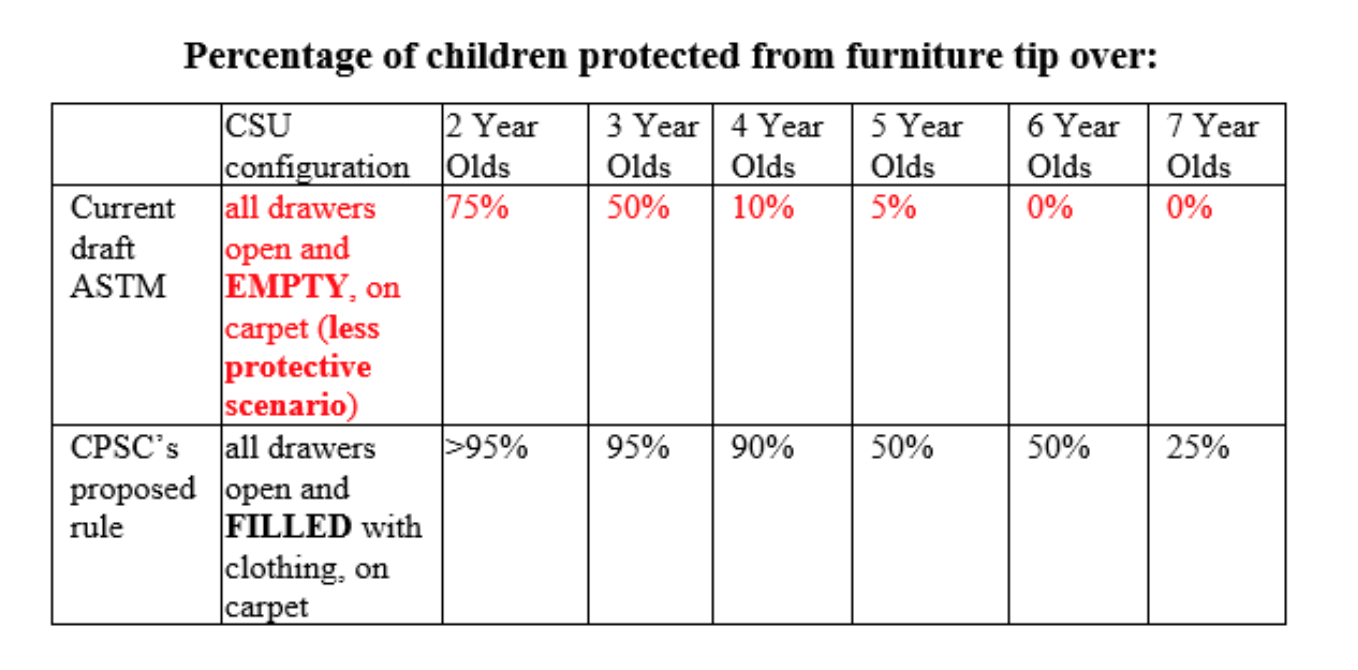CPSC Makes Grave Error, Increasing Children’s Risk Of Death From Furniture Tip-Over And Creating Legal Peril For Agency
I am disappointed and saddened by today’s vote. Today, the Consumer Product Safety Commission is ignoring the recommendation of its own scientists and leaving children in danger.
On October 19, 2022, and in response to the almost-200 child deaths that occurred between January 2000 and April 2022, CPSC approved a final rule to protect children from dressers tipping over and killing them. Today, the agency has abandoned that highly protective dresser tip-over rule that CPSC scientists developed after years of rigorous testing and decades of failed negotiations with industry. The Commission rejected the recommendation of agency staff and instead caved to outside pressure, rubberstamping a rule that the furniture industry wrote for itself (ASTM F2057) and that our scientists vigorously opposed.
Consumers are now forced to accept that more children will be crushed to death in tip-over accidents. Those deaths will have been preventable. Specifically, we anticipate that at least one child will die every year as a result of today’s decision. That breaks my heart. And I wonder who is going to explain today’s decision to their parents. Who will explain that the Commission failed them because it chose the path of least resistance, instead of the path that would have saved their child’s life.
On December 29th, 2022, Congress enacted a law called the STURDY Act which directs CPSC to review whether any industry standard for dresser stability meets certain exacting standards. CPSC can adopt the latest industry-written rule only if it meets a rigorous test—at a minimum, it must “protect children up to 72 months of age from death or injury” with—
- Tests that simulate the weight of children up to 60 pounds;
- Objective, repeatable, reproducible, and measurable tests or series of tests that simulate real-world use and account for impacts on clothing storage unit stability that may results from placement on carpeted surfaces, drawers with items in them, multiple open drawers, and dynamic force;
- Testing of all clothing storage units, including those 27 inches and above in height.”
The industry-written rule fails each of those requirements, and CPSC lacks the authority to override Congress. The industry rule does not protect children up to 72 months of age and also fails (A), (B), and (C).
|
Protects children up to 72 months of age? |
No.
|
|
Simulates the weight of children up to 60 pounds? |
No. The industry-written rule uses a 60-pound static weight placed on an open dresser drawer to simulate the weight of a child. CPSC staff found that method to be an invalid simulation. |
|
Simulates real-world use? |
No. The industry-written rule fails to simulate real-world use because multiple conditions occur simultaneously in the real world, such as dressers that are (a) filled with clothing and (b) situated on carpeted floor and (c) subject to the simulated weight of a child pulling on a drawer. The industry-written rule assesses each of these stability elements separately, which does not reflect reality. |
|
Simulates dynamic force? |
No. CPSC staff determined that the industry-written rule’s horizontal pull test using a 10-pound static force “is lower than demonstrated child strength, and does not appear to be a simulated dynamic force, as claimed.” CPSC staff also determined that the industry-written rule’s test with a static 60-pound weight placed on an open dresser drawer fails to simulate dynamic forces and “substantially underestimates the forces generated during child climbing interactions.” |
|
Requires testing of all clothing storage units? |
No. The industry-written rule excludes dressers that are 30 pounds or lighter unloaded, even though clothing adds weight to a dresser and dresser-weight is a critical risk factor in tip-overs. Dressers with less than 3.2 cubic feet of enclosed storage and certain arbitrary product categories that are at the seller’s marketing/labeling discretion are also excluded. |
In the real world, outside of the furniture industry’s labs, dresser tip-overs occur when multiple common factors occur at the same time—the drawers are filled with clothing, and a child climbs up on a dresser sitting on carpet. Under those multi-factor scenarios, our staff assessed that 0% of typical weight 6-year-olds would be protected and only 10% of typical weight 4-year-olds would be protected by the rule we adopted today:

That’s why less than a year ago, CPSC’s own scientists wrote that the industry-written rule is inadequate to address the hazard of unstable furniture, saying that the tests included in that rule: “would not adequately address the hazards because they fail to address multiple real-world conditions simultaneously; and they fail to … simulate the interactions seen in the hazard patterns, based on the climbing forces identified by the child climbing study and pull forces in child strength literature.”
On June 3, 2022, CPSC staff articulated three key safety deficiencies in the industry-written rule:
- Tests do not simulate multiple simultaneous factors that are demonstrated to decrease stability and to simultaneously exist during known incidents—i.e., multiple open/filled drawers, carpet, and forces from children’s dynamic interactions.
- The test in Section 9.2.3, Simulating a Reaction on Carpet with Child Weight, uses a 60-pound test weight placed on the edge of an open drawer. The balloted language implies that the 60-pound test weight represents the body weight of a child, and that the test simulates a child’s interaction force. However, the Child Climbing Study (Tab R) and analysis in the CPSC staff briefing package demonstrates that the Center of Mass of a child climbing would be outboard of the drawers. Static body weight in line with the edge of the drawer (as proposed in Section 9.2.3) substantially underestimates the forces generated during child climbing interactions. Incident data shows climbing interactions to be among the most common interactions during incidents.
- The pull force in the test in Section 9.2.2 is lower than demonstrated child strength, and does not appear to be a simulated dynamic force, as claimed.
CPSC’s vote today puts this rule in serious legal jeopardy by attempting to override the criteria set by Congress. It could fail as arbitrary and capricious if challenged in court and leave children without protection from tip-overs.
11Letter from CPSC staff to Richard Rosati, Chair, ASTM F15.42 Furniture Safety Subcommittee, Re: Negative Vote for ASTM Ballot F15 (22-06), Item 8 (June 3, 2022).



